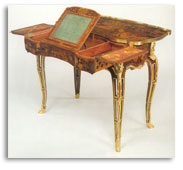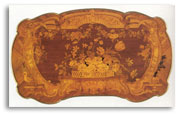handmade furniture craftsmen in France worked within a strictly controlled guild system. Between 1743 and 1751, they had to stamp their initials on their work, followed by the letters J.M.E. (jure des menuisiers et ebenistes). As a result, much French furniture can be attributed to specific makers.
Lady's Writing Table
This lady's writing table was made for Madame de Pompadour, Louis XV's mistress, by the German born maker - Jean-Francois Oeben.
This piece of non fitted furniture is made of oak and veneered with mahogany, kingswood, tulipwood, and various other woods. Decorated with gilt-bronze mounts and the top displays marquetry patterns reflecting Madame de Pompadour's love of the arts, including a vase of flowers, as well as designs representing architecture, painting, music and gardening.
Elements from the owners coat of arms are included on the gilt-bronze mounts on each corner. When the top slides back to reveal the workings of the writing table, the surface area is almost doubled.


Le Style Moderne
With origins in Regence design, Rococo, also known as the style moderne, ignored the rules of Classical architecture and was, essentially, a fantasy style with scrolls, shells, grotesque ornament, and foliage rendered in an unnaturalistic style. Ormolu mounts and carved decorations were very popular.
The style became sort after by the French nobility and spread through Europe, owing to the influence of artisans such as Juste-Aurele Meissonnier, a designer of gold and silver items.
Along with Jean Baptiste Pillement, Meissonnier developed the 'genre pittoresque' (the original term for Rococo). Pillement's engravings were used for marquetry as well as textiles and ceramics, and featured Oriental motifs including stylized Chinese figures, swirling foliage and flowers.
Secretaire A Abattant
This serpentine fronted secretaire is veneered in tulipwood, inlaid on the diagonal. The upper section opens to reveal a writing surface and six drawers. Ormolu banding frames and marquetry panels.
Decorative Influences
The sculptor and architect Nicolas Pineau published designs for carved decoration for walls, ceilings, fireplaces, console tables, and torcheres, now used in reproduction furniture, which were widely used by cabinet makers such as Charles Cressent. These engravings spread the Rococo influence across the continent.
The paintings of Jean-Antoine Watteau introduced a new decorative feature, the fete galante. These garden scenes, showing aristocratic couples in amorous pursuits, were depicted in marquetry, painted furniture, and tapestries and textiles.
No comments:
Post a Comment